All issues
- 2024 Vol. 16
- Issue 1 (special issue)
- 2023 Vol. 15
- 2022 Vol. 14
- 2021 Vol. 13
- 2020 Vol. 12
- 2019 Vol. 11
- 2018 Vol. 10
- 2017 Vol. 9
- 2016 Vol. 8
- 2015 Vol. 7
- 2014 Vol. 6
- 2013 Vol. 5
- 2012 Vol. 4
- 2011 Vol. 3
- 2010 Vol. 2
- 2009 Vol. 1
Modeling the kinetics of radiopharmaceuticals with iodine isotopes in nuclear medicine problems
 pdf (3912K)
pdf (3912K)
Radiopharmaceuticals with iodine radioisotopes are now widely used in imaging and non-imaging methods of nuclear medicine. When evaluating the results of radionuclide studies of the structural and functional state of organs and tissues, parallel modeling of the kinetics of radiopharmaceuticals in the body plays an important role. The complexity of such modeling lies in two opposite aspects. On the one hand, excessive simplification of the anatomical and physiological characteristics of the organism when splitting it to the compartments that may result in the loss or distortion of important clinical diagnosis information, on the other – excessive, taking into account all possible interdependencies of the functioning of the organs and systems that, on the contrary, will lead to excess amount of absolutely useless for clinical interpretation of the data or the mathematical model becomes even more intractable. Our work develops a unified approach to the construction of mathematical models of the kinetics of radiopharmaceuticals with iodine isotopes in the human body during diagnostic and therapeutic procedures of nuclear medicine. Based on this approach, three- and four-compartment pharmacokinetic models were developed and corresponding calculation programs were created in the C++ programming language for processing and evaluating the results of radionuclide diagnostics and therapy. Various methods for identifying model parameters based on quantitative data from radionuclide studies of the functional state of vital organs are proposed. The results of pharmacokinetic modeling for radionuclide diagnostics of the liver, kidney, and thyroid using iodine-containing radiopharmaceuticals are presented and analyzed. Using clinical and diagnostic data, individual pharmacokinetic parameters of transport of different radiopharmaceuticals in the body (transport constants, half-life periods, maximum activity in the organ and the time of its achievement) were determined. It is shown that the pharmacokinetic characteristics for each patient are strictly individual and cannot be described by averaged kinetic parameters. Within the framework of three pharmacokinetic models, “Activity–time” relationships were obtained and analyzed for different organs and tissues, including for tissues in which the activity of a radiopharmaceutical is impossible or difficult to measure by clinical methods. Also discussed are the features and the results of simulation and dosimetric planning of radioiodine therapy of the thyroid gland. It is shown that the values of absorbed radiation doses are very sensitive to the kinetic parameters of the compartment model. Therefore, special attention should be paid to obtaining accurate quantitative data from ultrasound and thyroid radiometry and identifying simulation parameters based on them. The work is based on the principles and methods of pharmacokinetics. For the numerical solution of systems of differential equations of the pharmacokinetic models we used Runge–Kutta methods and Rosenbrock method. The Hooke–Jeeves method was used to find the minimum of a function of several variables when identifying modeling parameters.
Indexed in Scopus
Full-text version of the journal is also available on the web site of the scientific electronic library eLIBRARY.RU
The journal is included in the Russian Science Citation Index
The journal is included in the RSCI
International Interdisciplinary Conference "Mathematics. Computing. Education"






